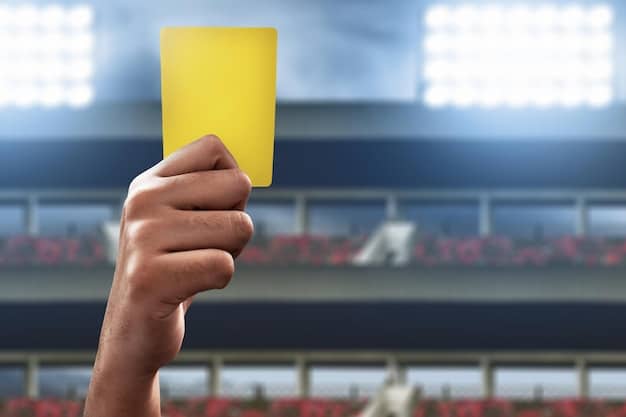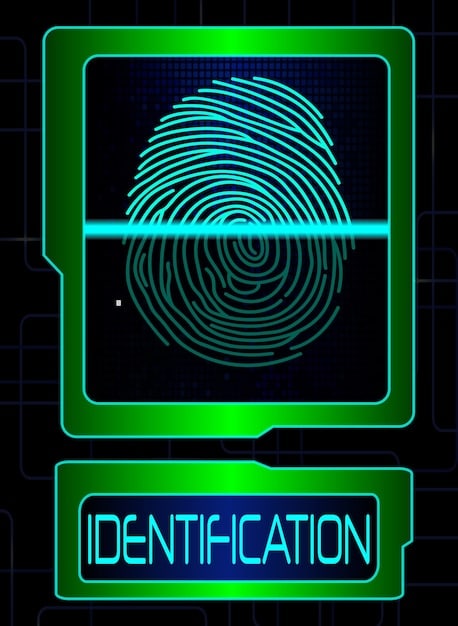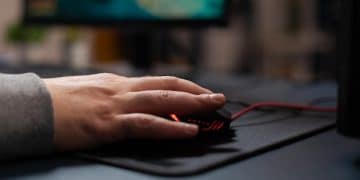US Esports Tournament Organizers: Fair Play in 2025

Ensuring fair play in US esports tournaments by 2025 demands comprehensive anti-cheat systems, transparent rule enforcement, robust dispute resolution, and continuous adaptation to evolving game mechanics and player conduct, fostering competitive integrity and trust within the community.
As the competitive gaming landscape expands, the integrity of matches becomes paramount. For US Esports Tournament Organizers: What are the Best Practices for Ensuring Fair Play in 2025? This article delves into the crucial strategies and evolving technologies necessary to maintain a level playing field, ensuring every competition is decided purely by skill and strategy.
The Evolving Landscape of Esports Integrity
The burgeoning esports industry, particularly in the US, relies heavily on the trust players and fans place in its competitive integrity. As prize pools grow and viewership numbers climb, the temptation for unfair play intensifies, posing significant challenges for tournament organizers. Maintaining fair play is not merely about adhering to rules; it’s about safeguarding the very spirit of competition. This involves a multi-faceted approach, integrating technology, human oversight, and clear communication.
In 2025, the landscape of esports has matured considerably. What was once seen as a niche hobby has transformed into a global spectacle with professional athletes and dedicated fan bases. This growth, however, brings increased scrutiny and demands for sophisticated systems that can deter, detect, and address unfair advantages effectively. The goal is to create environments where skill, strategy, and teamwork are the only determinants of victory.
Technological Fortifications Against Cheating
One of the primary battlegrounds for fair play is the prevention and detection of cheating software. Advanced anti-cheat systems are the first line of defense, but their effectiveness depends on constant updates and proactive development to keep pace with new exploits. The integration of artificial intelligence (AI) and machine learning (ML) is becoming increasingly vital.
- AI-Powered Monitoring: AI can analyze gameplay patterns in real-time, identifying unusual behaviors that might indicate botting, aim-assisting, or other illicit activities that human observers might miss.
- Hardware-Based Security: Exploring hardware-level security measures that tie game clients directly to verified hardware can prevent tampering and unauthorized software injection, effectively creating a more secure environment.
- Continuous Software Updates: Anti-cheat software must be updated frequently, often in tandem with game patches, to address new vulnerabilities and counter novel cheating methods as they emerge.
These technological solutions require significant investment and expertise. Tournament organizers must collaborate closely with game developers and cybersecurity experts to ensure their anti-cheat measures are robust and future-proof. It’s a continuous arms race where innovative solutions are always needed to stay ahead of those seeking an unfair advantage.
Beyond active anti-cheat, the integrity of game clients themselves is crucial. Secure client authentications and encrypted network traffic are foundational elements to prevent data manipulation or intercepting sensitive information. The objective is to build an ecosystem where the opportunities for cheating are minimized from the outset, providing a strong deterrent effect.
Transparency and Clear Rule Enforcement
Beyond technology, the human element of rule enforcement and transparency builds trust. Players need to understand clearly what constitutes fair and unfair play. Ambiguity in rules can lead to disputes, dissatisfaction, and a perception of bias. By 2025, robust and accessible rulebooks are non-negotiable.
A well-defined rulebook should cover every conceivable scenario, from in-game exploits to player conduct outside of the game itself that might impact competitive integrity. This includes clear definitions of harassment, wintrading, match-fixing, and the use of unauthorized peripherals. The language used should be precise, leaving minimal room for misinterpretation.
Accessible Rulebooks and Educational Programs
Simply having a rulebook is not enough; it must be easily accessible and understandable. Tournament organizers should consider:
- Multi-Format Presentation: Offering rulebooks in various formats (e.g., PDF, interactive web pages, video explanations) to cater to different learning styles.
- Pre-Tournament Briefings: Mandating and thoroughly conducting pre-tournament briefings where key rules are highlighted, and players have an opportunity to ask questions.
- Educational Content: Developing educational content that explains the reasoning behind certain rules, fostering a culture of understanding and adherence rather than mere compliance.
Furthermore, the enforcement of these rules must be consistent and unbiased. Any perception of favoritism or inconsistent penalties can quickly erode trust within the community. Tournament organizers should employ independent officials or third-party adjudicators to ensure impartiality in rulings.
The communication of rule changes or interpretations is equally important. Players should be informed well in advance of any updates. Regular public discussions or forums where players can provide feedback on rules can also contribute to a sense of community ownership and collective responsibility for fair play.
Robust Dispute Resolution Mechanisms
Even with the best preparation, disputes will inevitably arise. How these disputes are handled plays a critical role in maintaining the perception of fairness. A well-structured and transparent dispute resolution system is essential, providing players with a clear pathway to address grievances and seek recourse.
In 2025, dispute resolution should move beyond simple appeals. It should involve multi-tiered systems that cater to different levels of complexity and severity. This could range from on-site referees handling minor in-game issues to independent commissions for major allegations like match-fixing or severe code of conduct violations.
Key Components of Effective Dispute Resolution
Effective dispute resolution relies on several pillars:
- Dedicated Officials: Having trained and experienced officials who understand both the game mechanics and the rules of competitive play.
- Defined Procedures: Clearly outlining the steps for filing a complaint, the evidence required, and the timeline for resolution. This reduces frustration and ensures everyone understands the process.
- Appeals Process: Establishing an independent appeals process where decisions can be reviewed by a higher authority, ensuring checks and balances.
- Transparency of Outcomes: While protecting individual privacy, making the outcomes of major disputes public (e.g., “Player X was suspended for Y weeks due to Z rule violation”) reinforces accountability and deterrence.
The ability to handle disputes swiftly and fairly prevents small issues from escalating into larger controversies that could damage the tournament’s reputation. Independent oversight bodies or panels, composed of experts in esports law, ethics, and game mechanics, can add an invaluable layer of credibility to the dispute resolution process.

Furthermore, psychological support for players involved in disputes can be considered, especially in cases of severe allegations. The mental toll of being accused or having to prove misconduct can be significant, and a holistic approach to player welfare contributes to overall tournament health.
Player Education and Professionalism
True fair play extends beyond enforcing rules; it involves cultivating a culture of professionalism and sportsmanship among players. Educating players about the importance of integrity, the consequences of unfair play, and their responsibilities as competitive athletes is a proactive step towards fostering a healthy esports ecosystem.
Professional esports players are role models for aspiring gamers. Their conduct, both in and out of the game, influences the community. Tournament organizers have a role to play in shaping this culture by providing resources and setting expectations for professional behavior.
Developing a Culture of Integrity
Initiatives for player education and professionalism might include:
- Code of Conduct Workshops: Regular workshops that educate players on ethical play, anti-doping policies in esports, and the long-term career implications of breaching integrity.
- Mental Health Support: Recognizing that player well-being can impact decision-making, offering mental health resources can help prevent burnout and poor choices under pressure.
- Ambassador Programs: Encouraging experienced and respected players to act as ambassadors for fair play, leading by example and mentoring newer talent.
- Reporting Mechanisms: Establishing easy and anonymous ways for players to report suspicious activity without fear of retaliation, fostering a community that actively participates in maintaining integrity.
By investing in player education, tournament organizers empower athletes to make ethical choices and understand the broader impact of their actions on the esports community. This proactive approach helps to prevent issues before they occur, reducing the reliance solely on detection and punishment.
The integration of players into the rule-making process, through player councils or regular feedback sessions, can also build a stronger sense of shared responsibility. When players feel their voices are heard, they are more likely to internalize and uphold the standards of fair play.
Adapting to Evolving Game Mechanics and Exploits
Esports games are dynamic, with frequent updates, new characters, maps, and mechanics. Each change presents potential new avenues for exploits or unintended interactions that can be leveraged for unfair advantage. Tournament organizers must be agile and proactive in adapting their fair play measures to these evolving game ecosystems.
This requires close collaboration with game developers to understand upcoming changes and identify potential vulnerabilities before they are exploited in competitive play. It’s an ongoing process of risk assessment and mitigation unique to the digital nature of esports.
Strategies for Dynamic Adaptation
To stay ahead, organizers should focus on:
- Pre-Patch Analysis: Working with game developers to thoroughly analyze upcoming patches for any potential game-breaking bugs or exploits that could impact competitive integrity.
- Dedicated “Meta” Teams: Employing specialized staff or consultants who continually monitor the game’s meta (most effective tactics available) for new strategies that might border on unfair exploitation.
- Live Monitoring and Rapid Response: During tournaments, having dedicated staff who can identify and address exploits being used in real-time, with clear protocols for halting matches or applying penalties.
- Post-Tournament Review: Conducting thorough post-tournament reviews to identify any exploits that were used and update rules or anti-cheat systems accordingly for future events.
The goal is to maintain a balance between allowing innovative strategies and preventing malicious exploitation of game mechanics. A clear process for defining what constitutes an “exploit” versus a “clever strategy” is crucial and often requires expert consensus from game developers and experienced players.

Furthermore, the use of hardware and peripherals also evolves. Organizers need to have clear guidelines and rigorous checks to prevent the use of unauthorized devices that offer an unfair advantage, such as macro-enabled keyboards or modified controllers. This includes routine checks of player equipment before and during matches.
Future-Proofing Fair Play: Web3 and AI Ethics
As we look beyond 2025, emerging technologies like Web3 (blockchain, NFTs, decentralized systems) and increasingly sophisticated AI present both challenges and opportunities for fair play. Tournament organizers must start considering how these innovations will shape the future of competitive integrity.
Blockchain technology, for instance, could offer unprecedented transparency in tracking player histories, match results, and even prize distribution, potentially reducing disputes related to record-keeping. AI, while already used for anti-cheat, will become even more powerful, but brings ethical considerations regarding surveillance and bias.
Leveraging New Technologies Responsibilities
Considerations for future-proofing include:
- Blockchain for Data Integrity: Exploring how blockchain can securely store player profiles, competitive records, and ban lists, creating an immutable and transparent ledger of competitive history.
- Ethical AI Development: Ensuring that AI-powered anti-cheat and monitoring systems are developed and deployed ethically, guarding against algorithmic bias and respecting player privacy.
- Decentralized Governance: Investigating models where aspects of fair play enforcement or rule-making could be partly governed by the community through decentralized autonomous organizations (DAOs), offering a new level of transparency and player voice.
- AI for Predictive Analytics: Using advanced AI to identify potential risks of match-fixing or illicit activities by analyzing betting patterns and player behavior across a wider dataset, moving from reactive detection to proactive prevention.
The integration of these technologies requires careful planning and collaboration with experts in each field. It’s not just about adopting new tools but understanding their implications for player rights, data security, and the overall ethics of competitive play.
Balancing innovation with established principles of fair play will be key. The esports industry is still young and highly adaptable, positioning it uniquely to incorporate these advanced solutions responsibly, setting new benchmarks for competitive integrity in sports globally.
| Key Practice | Brief Description |
|---|---|
| 🛡️ Advanced Anti-Cheat | Deploys AI/ML systems and hardware security to detect and prevent cheating. |
| 🔍 Rule Transparency | Ensures clear, accessible rulebooks and consistent, unbiased enforcement. |
| ⚖️ Dispute Resolution | Establishes multi-tiered processes with independent appeals for fair grievance handling. |
| 🎓 Player Education | Fosters a culture of professionalism and sportsmanship through workshops and resources. |
Frequently Asked Questions
▼
The most significant challenge remains the rapid evolution of cheating methods. As anti-cheat systems become more sophisticated, so do the techniques used by cheaters. Organizers must continuously update their defenses and leverage AI/ML to stay ahead of novel exploits and maintain competitive integrity effectively.
▼
AI can analyze vast amounts of gameplay data in real-time, identifying abnormal patterns indicative of cheating. It also aids in detecting subtle behaviors that human observers might miss, such as micro-adjustments from aim-bots or unusual movement patterns, thereby enhancing detection capabilities and deterrence significantly.
▼
Transparent rule enforcement builds trust among players and fans. When rules are clear, accessible, and applied consistently, it reduces ambiguity and the perception of bias. This fosters a belief that competitions are fair and that results are based purely on skill, which is vital for the sport’s credibility and growth.
▼
Players are integral to fair play. By adhering to codes of conduct, reporting suspicious activities, and promoting sportsmanship, they contribute to a positive competitive environment. Player education programs and ambassador initiatives help instill a culture of integrity, making players active participants in upholding competitive standards.
▼
Organizers must maintain close communication with game developers to understand upcoming patches and potential vulnerabilities. Employing dedicated analysts, conducting pre-patch reviews, and implementing swift, decisive real-time responses to in-game exploits are critical. Post-tournament reviews also help refine rules and anti-cheat systems continuously for future events.
Conclusion
The pursuit of fair play in US esports tournaments by 2025 is an ongoing, dynamic process that fuses technological innovation with robust human oversight and ethical considerations. From advanced anti-cheat systems to clear rule enforcement, effective dispute resolution, and proactive player education, each component plays a pivotal role. The burgeoning growth of esports demands unwavering commitment from organizers to uphold competitive integrity, adapting continuously to evolving game mechanics and ethical questions posed by new technologies like Web3 and AI. Ultimately, a strong foundation of trust and fairness is essential for the long-term sustainability and global acceptance of esports as a legitimate and respected competitive arena.





